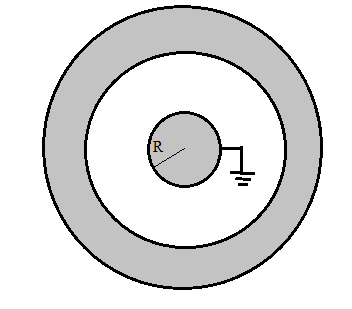
: A conducting sphere of radius R and a concentric thick spherical shell of inner radius 2R and outer radius 3R is shown in figure. A charge +10Q is given to the shell and the inner sphere is earthed. The charge on inner sphere is

A. -4Q
B. -10Q
C. zero
D. none

Answer
436.2k+ views
Hint: The arrangement of the conductors is such that they form a spherical capacitor. Since we earthed the inner sphere, the potential difference between this sphere and the ground becomes zero i.e, the inner sphere is at a potential of V = 0.
Complete answer:
We are given that the inner sphere of radius R is earthed and surrounding it there is a spherical shell with inner radius 2R and Outer radius 3R. When a charge of +10Q is imparted to spherical shell (outer), this gets divided into two parts:
1. A charge
2. A charge of
Due to a charge
The potential
We keep
Where
The inner surface of the shell should contribute some potential difference given by:
Equating the two potential differences, we get:
Or, we can simplify this as:
Which gives us:
Since in the beginning of the discussion, we saw that
So, the correct answer is “Option A”.
Note:
One potential difference is derived by integrating net Electric field outward and another is derived from net electric field inwards (between the inner sphere and outer shell). We equated the two potential differences i.e., one at a point outside the arrangement and one in between the two spheres.
Complete answer:
We are given that the inner sphere of radius R is earthed and surrounding it there is a spherical shell with inner radius 2R and Outer radius 3R. When a charge of +10Q is imparted to spherical shell (outer), this gets divided into two parts:
1. A charge
2. A charge of
Due to a charge
The potential
We keep
Where
The inner surface of the shell should contribute some potential difference given by:
Equating the two potential differences, we get:
Or, we can simplify this as:
Which gives us:
Since in the beginning of the discussion, we saw that
So, the correct answer is “Option A”.
Note:
One potential difference is derived by integrating net Electric field outward and another is derived from net electric field inwards (between the inner sphere and outer shell). We equated the two potential differences i.e., one at a point outside the arrangement and one in between the two spheres.
Recently Updated Pages
Basicity of sulphurous acid and sulphuric acid are

Master Class 12 Economics: Engaging Questions & Answers for Success

Master Class 12 Maths: Engaging Questions & Answers for Success

Master Class 12 Biology: Engaging Questions & Answers for Success

Master Class 12 Physics: Engaging Questions & Answers for Success

Master Class 4 Maths: Engaging Questions & Answers for Success

Trending doubts
Give 10 examples of unisexual and bisexual flowers

Draw a labelled sketch of the human eye class 12 physics CBSE

a Tabulate the differences in the characteristics of class 12 chemistry CBSE

Differentiate between homogeneous and heterogeneous class 12 chemistry CBSE

Why is the cell called the structural and functional class 12 biology CBSE

Differentiate between insitu conservation and exsitu class 12 biology CBSE




